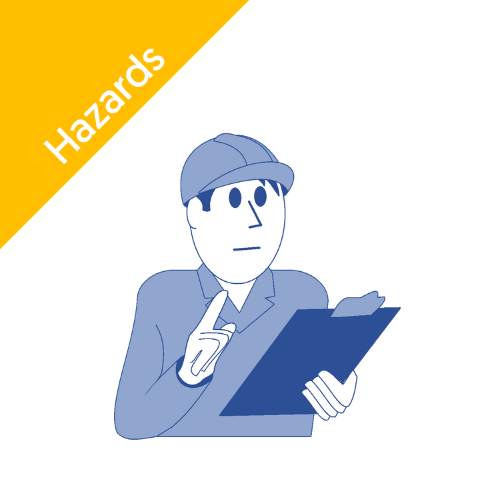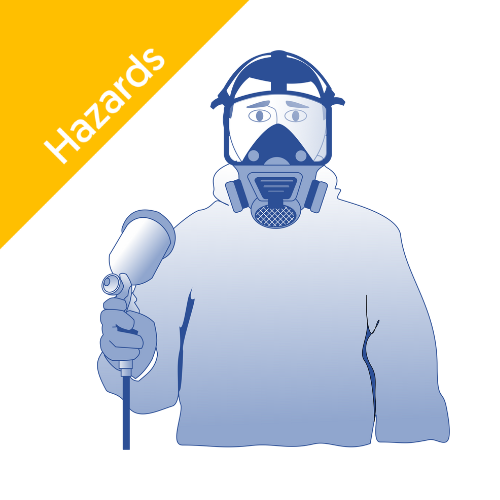What are Isocyanates and Their Hazards?
Isocyanates are organic compounds that react with other chemicals to form polyurethane products. When sprayed, heated, or mixed, they can become airborne as vapours or mists. These are powerful irritants that can affect the respiratory tracts, skin, and eyes, causing both immediate and long-term health effects.
Common health hazards include:
Occupational asthma – sensitisation can occur after repeated low-level exposure or a single high exposure.
Dermatitis – inflammation of the skin from direct contact.
Eye irritation – redness, watering, and discomfort.
Chronic respiratory issues – long-term exposure may result in serious lung conditions.
Common Types of Isocyanates
Key isocyanates or diisocyanates (a diisocyanate is a type of isocyanate that contains two isocyanate functional groups) commonly found in workplaces include:
Methylene diphenyl diisocyanate (MDI) – used in rigid foams and adhesives
Toluene diisocyanate (TDI) – found in flexible foams and coatings; highly volatile
Hexamethylene diisocyanate (HDI) – used in automotive coatings and spray paints
Isophorone diisocyanate (IPDI) – used in high-performance coatings
Knowing the specific diisocyanates used in your workplace helps target your risk assessment and safety controls effectively.
High-Risk Industries and Jobs
Certain workplaces see more frequent isocyanate exposure, particularly where products are sprayed, heated, or sanded. Common high-risk applications include:
Industry | Common Tasks |
|---|
Motor Vehicle Repair / Auto Body Shops | Spray painting, 2K coatings, dent repair with bonding compounds |
Construction | Spray polyurethane foam, flooring, adhesives, coatings |
Manufacturing | Production of polyurethane foams, elastomers, plastics, rubbers, furniture |
Industrial Coatings | Truck bed linings, surface coatings, undercoating heavy equipment |
Workers using spray polyurethane foam (SPF) or low molecular weight isocyanates face the highest inhalation risks and require strict control measures.
Legal Requirements in the UK
COSHH Regulations 2002
Under COSHH, employers must prevent or adequately control exposure to hazardous substances, including isocyanates. Key duties include:
Conducting a suitable and sufficient risk assessment
Implementing effective control measures (engineering, procedural, PPE)
Providing employees with information, instruction, and training
Maintaining health surveillance and proper documentation
Safety Data Sheets (SDS) & Exposure Limits
SDS provide detailed guidance on chemical hazards, safe handling, and emergency measures.
Workplace Exposure Limits (WELs) for isocyanates in air, set by the HSE are legally binding:
You can read about Isocyanate Regulations in the UK to understand the employer's legal responsibilities for dealing with isocyanates in the workplace.
Conducting a Workplace Risk Assessment for Isocyanates
A practical risk assessment involves the “Assess, Control, Review” approach:
Identify hazards – examine which products, tasks, and processes involve isocyanates.
Evaluate risks – consider who may be exposed, how, where, and for how long.
Implement controls – follow the hierarchy of controls (elimination, engineering, work practices, PPE).
Review regularly – update assessments after incidents, process changes, or new hazard information.
To help you get it right, we created a COSHH Risk Assessment Template that you can download for free.
Hierarchy of Controls & Practical Measures
Elimination or Substitution
Engineering Controls
Enclosed spray booths with local exhaust ventilation (LEV)
High-volume, low-pressure (HVLP) spray guns to reduce overspray
Improved general ventilation in workshops
Work Practices
Minimise aerosol generation; use rollers or brushes instead of spraying when possible
Schedule high-exposure tasks to limit the number of workers present
Maintain hygiene: hand washing, PPE donning/doffing areas
Personal Protective Equipment (PPE)
Respiratory Protective Equipment (RPE): air-fed or filtered for specific vapours
Gloves: nitrile or chemically resistant, disposable
Eye protection: goggles or face shields
Overalls: disposable or protective clothing covering personal wear
Training on proper PPE use, maintenance, and fit testing is essential to ensure effectiveness.
Health Surveillance & Biological Monitoring
Regular monitoring helps detect early signs of exposure:
Respiratory health checks – spirometry and questionnaires
Skin checks – identify dermatitis early
Biological monitoring – urine testing for isocyanate metabolites
Health surveillance is legally required under COSHH where there is a risk of occupational asthma or dermatitis.
Read our article for more information about Monitoring and Health Surveillance.
Recognising Early Symptoms
Educate employees to spot early warning signs of exposure:
Persistent coughing or wheezing
Chest tightness or shortness of breath
Runny or irritated eyes/nose
Skin rashes or redness
Immediate reporting and intervention can prevent long-term or chronic health effects.
Emergency Response & Spill Management
Prepare a clear plan for spills or accidental exposure:
Evacuate non-essential personnel.
Wear appropriate PPE before clean-up.
Contain and clean spills using absorbent materials.
Wash exposed skin thoroughly with soap and water.
Seek medical attention if necessary.
Report the incident and review risk controls.
Staff Training & Awareness
Commodious COSHH Awareness Training is ideal for all staff handling any hazardous substance. Training should include:
Understanding health hazards
Correct use of PPE and ventilation systems
Reading and applying SDS information
Spill response and emergency procedures
Legal compliance under COSHH and UK REACH
Combined with mandatory diisocyanate safety training, this ensures a well-prepared workforce.
Conclusion
Effective risk assessment and control measures are essential for preventing occupational asthma and other isocyanate-related health hazards. By implementing the hierarchy of controls, maintaining PPE, providing staff training, and conducting health surveillance, employers can create a safe workplace in construction, motor vehicle repair, industrial coating, and manufacturing environments.
FAQs
Are there any safe levels of isocyanate exposure?
How can employers ensure COSHH compliance?
Conduct thorough risk assessments, follow the hierarchy of control, provide training and supervision, and maintain proper documentation.
How often should risk assessments be reviewed?






